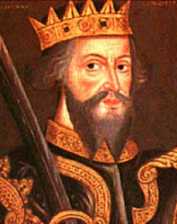Charles Ryland Scott Family
Ancestors and Descendants
Person Page 4,321
William I ("The Conqueror") Of Normandy, King Of England
M, b. 1028, d. 9 September 1087
Child with Matilda Of Flanders (b. circa 1031, d. 2 November 1083)
| Son | Henry I ("Beauclerc") Of Normandy, King Of England+ (b. circa 1068, d. 1 December 1135) |
| Pedigree Chart | |
| Included in charts - lists | Box Pedigree - CRS Charles Ryland Scott Ancestors Indented - CRS Relationship to William the Conqueror |
| Relationship | 27th great-grandfather of Charles Ryland ("Ryland") Scott 29th great-grandfather of Isaac Silas Vaughn 29th great-grandfather of Katherine Gilstrap Scott 29th great-grandfather of Joseph Ryland Scott 29th great-grandfather of Charles Parker ("Parker") Scott 29th great-grandfather of Orly Marie Vaughn 29th great-grandfather of Avital Catherine Vaughn |
Person Exhibits

King William I
Biography
| Anecdote | Reigned 1066-1087. Duke of Normandy 1035-1087. Invaded England defeated and killed his rival Harold at the Battle of Hastings and became King. The Norman conquest of England was completed by 1072 aided by the establishment of feaudalism under which his followers were granted land in return for pledges of service and loyalty. As King William was noted for his efficient if harsh rule. His administration relied upon Norman and other foreign personnell especially Lanfranc Archbishop of Canterbury. In 1085 started Domesday Book. William's coronation took place in Westminster Abbey on Christmas Day 1066. He completed the establishment of feudalism in England, compiling detailed records of land and property in the Domesday Book, and kept the barons firmly under control. He died in Rouen after a fall from his horse and is buried in Caen, France. He was succeeded by his son William II. William's early years were marked by violence and disorder. In 1046 his cousin, Guy of Burgundy, led a revolt which forced the young duke to seek the aid of his overlord, Henry I of France. With Henry's help, William defeated Guy at Val-és-Dunes, and firmly secured control over Normandy. In 1051–52 William and Henry besieged and captured Domfront castle and Alençon in Maine, France. Almost immediately afterwards, William, Count of Arques, rebelled against the duke with the support of Henry I, who was increasingly concerned about Normandy's growing power. William quickly besieged the rebel Arques-la-Bataille castle and it was surrendered to him in 1053. In 1054 Henry I and Geoffrey of Anjou invaded Normandy, but the annihilation of part of their force at Mortimer forced them to withdraw. Their second invasion, in 1057, was defeated at Varaville. In 1051 Edward the Confessor had nominated William as heir to the English throne, but when he died in January 1066 Harold (II) Godwinson was crowned. William immediately began preparations for an invasion of England. On 28 September his forces landed unopposed at Pevensey, Sussex. Harold was in the north of England defeating an invasion led by Harald Hardrada, King of Norway, but immediately marched south to meet William. Their armies clashed in the Battle of Hastings on 14 October 1066. Harold was slain and William achieved a decisive victory. In 1067 William forcibly brought southwest England under his control. In 1068 he marched north and east to establish a number of strategic fortifications. In the summer of 1069 Swein Estrithson of Denmark landed with a considerable force in the Humber and was welcomed by the northern English earls who joined him in expelling the Norman garrison at York. William immediately marched north, destroying everything in his path, and reoccupied York. He undertook a systematic harrying of the north, setting his troops to kill and burn in order to leave nothing that could support future rebellion. The Danish fleet was bought off and departed. In 1072 William led an invasion that forced King Malcolm of Scotland to surrender hostages and swear fealty. In 1073 he was back in France suppressing rebellion in Maine. His regents dealt with a rebellion by the English earls in 1075, and in the latter years of his reign, William twice faced rebellion in Normandy led by his eldest son, Robert (II) Curthose. In 1087 William sacked the French-controlled town of Mantes in the Vexin. In the fighting he suffered a fatal internal injury after being thrown against the pommel of his saddle. He was taken to the priory of Saint-Gervais near Rouen where on 9 September he died. | |
| Birth | 1028 | William I ("The Conqueror") Of Normandy, King Of England, was born in 1028 in Falaise, Normandy, FranceBG. |
| Marriage | 1053 | He and Matilda Of Flanders were married in 1053 in Caen, Normandy, FranceBG. |
| Death | 9 September 1087 | He died on 9 September 1087 at age ~59 in Hermentrube, Near Rouen, FranceBGO. |
| Burial | He was buried in Caen, Normandy, FranceBG. |
| Last Edited | 24 June 2018 |